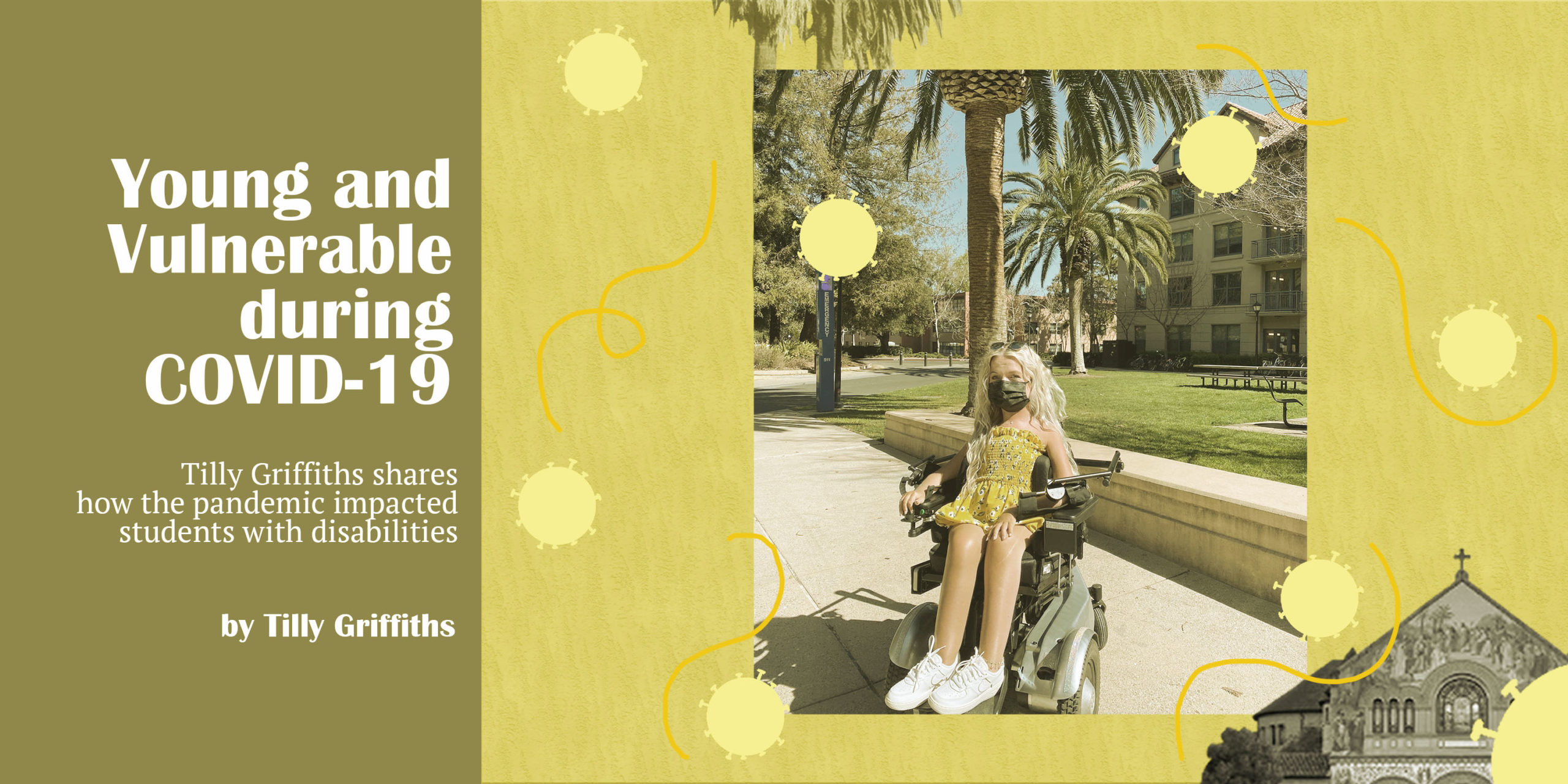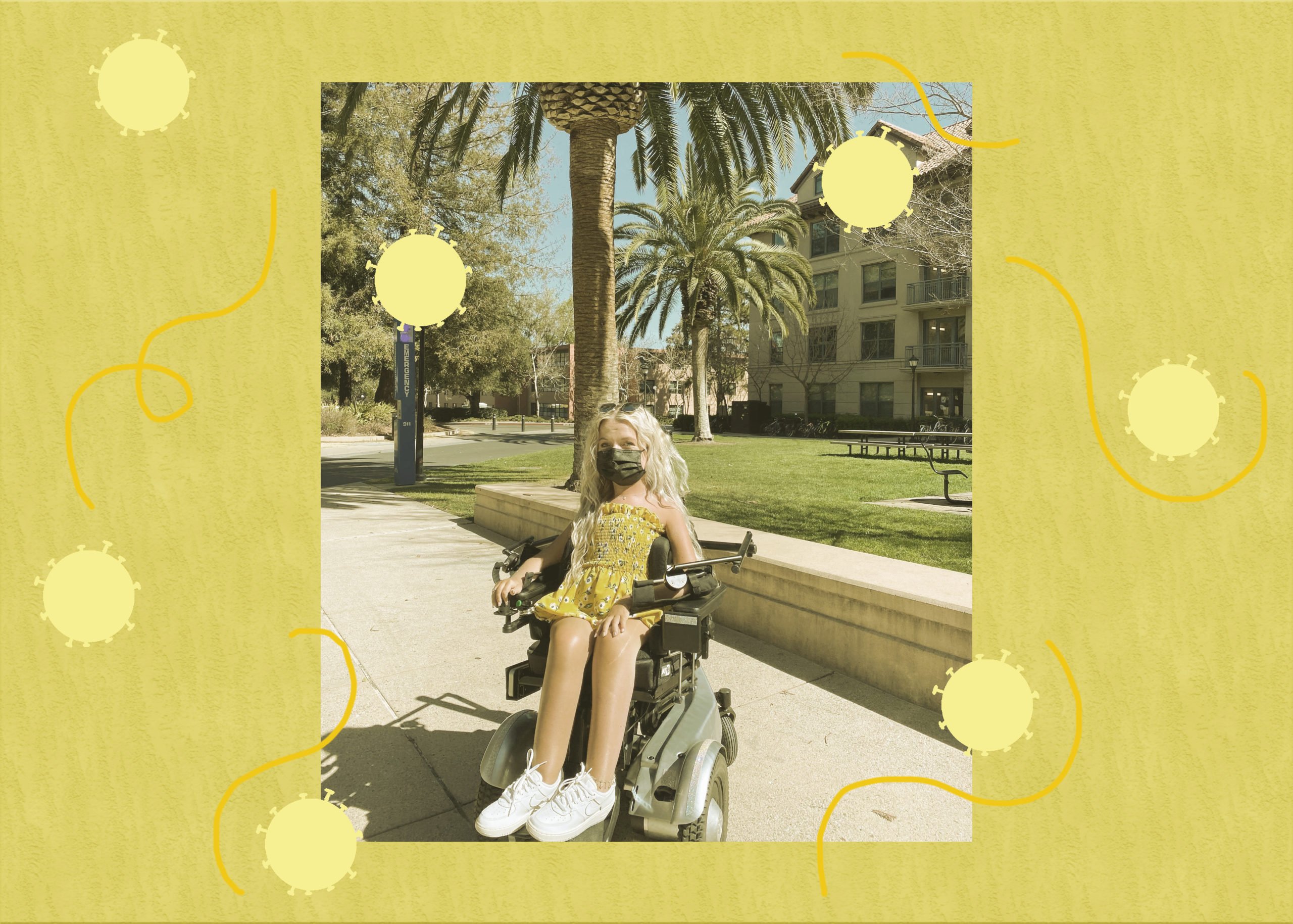
This article is part of a series reflecting on the anniversary of Stanford’s shutdown due to COVID-19. Click here to read the rest of the stories.
Pneumonia. Ventilation. Respiratory distress. The headlines of early 2020 signaling the arrival of the COVID-19 pandemic were all too familiar. No one could have known what was to come, but as someone with a preexisting medical condition, I was certain of the risks a virus of this kind presented to my health and acutely aware of the horrors that might lie ahead for us all. Confirming my worst suspicions, my doctor warned during a routine hospital procedure in early March, “Tilly, if this virus gets hold of you, it’s going to be very difficult for us to get you out the other side.” This is the reality of being young and vulnerable in the COVID-19 pandemic.
COVID-19 has reached every corner of the globe and touched all of our lives in some cruel way, but there is one portion of the population whose stories have remained largely untold. People with disabilities and preexisting health conditions have experienced the pandemic through an unparalleled lens of fear, frustration and devastation that continues to shape our personal responses to the crisis and highlights a system of injustice that goes far deeper than the present pandemic.
At the closure of the Stanford campus in March last year, the luckiest among us were able to retreat immediately into self-imposed, at-home isolation and rely on family members to provide vital care that would otherwise be completed by personal care attendants. Reducing the risk of COVID-19 entering our spaces became the first priority, so any contact from the outside world — even support from paid caregivers or medical treatment in the hospital setting — was avoided at all costs, and this isolation has remained the case even as formal stay-at-home restrictions continue to come and go. Siblings left the family home to safeguard vulnerable loved ones when learning from home was not an option. For some, even the backyard was off-limits for some time as official advice about the spreadability of the virus continued to evolve. While countries everywhere have imposed lockdown restrictions in some form, the quarantine-like behaviors practiced within the disability community since the beginning of the pandemic have been both all-encompassing and incessant and, although circumstances vary between individuals, many have not left the secure confines of their own homes to this day.
In addition to the challenge of rigid self-isolation, for Stanford students with disabilities the pandemic is a time of heightened emotions and painful reflections that will linger long past face masks and social distancing.
“Firstly, I’m angry. I’m angry that so many disabled lives have been lost and this pandemic has highlighted how disabled people are continually not prioritized,” Sylvia Colt-Lacayo ’24, who lives with a neuromuscular disease similar to muscular dystrophy, said. “It’s exhausting to be experiencing all these emotions at a time like this, but at the same time I want to use my anger to advocate for real, positive change for this community.”
Sylvia has been isolating at home with her family since the pandemic began, and described how she is still trying to process the hurt and frustration she experiences when observing others who flout COVID-19 safety measures. Family members and caregivers had to adapt to new, highly cautious behaviors that the “vulnerable” person feels responsible for, and sometimes trips outside of the home are necessary — seeing how the outside world may be responding less aggressively to the pandemic causes anxiety to reach an all-time high. As young people living with disabilities, lack of control is something we constantly grapple with, but the pandemic has amplified this by putting our lives quite literally in the hands of others and their willingness to keep everyone else safe. Sylvia said, “I try not to take the risky behavior of others personally, but it’s hard not to feel that people who take unnecessary risks on a regular basis simply don’t care whether people like me live or die.”
For many, being conscious of our vulnerable health and cognizant of our mortality is part of the norm. When the pandemic first arrived, I was bizarrely comforted by the fact that I’d been here before. My room on campus is filled with respiratory equipment to maintain my 20 percent lung capacity, I sleep with a non-invasive ventilator to support my breathing and I was under the impression that my childhood of emergency ICU admissions and frequent pneumonias would equip me with the tools and experience necessary to successfully take on COVID-19. I am extremely lucky that the healthcare system has always been ready and waiting to help pull me through.
Even so, the recent pressure on hospital capacity and the questions it has raised concerning how to choose between patients for life-saving treatment has been yet another blow to the disability community. As the pandemic reached its first peak, news articles circulated about people with disabilities being denied life-saving COVID-19 treatment and prompted the chilling realization that, when the system is stretched to its limit, not all lives are ultimately valued equally. Recent decisions taken against prioritizing young people with preexisting conditions in vaccine distribution programs then added to this trauma by reaffirming how people with disabilities and the heightened risk they currently face are simply not a priority for key decision-makers whose actions in theory reflect the beliefs of the wider society.
Ria Calcagno ’22, who lives with postural orthostatic tachycardia syndrome (POTS), spoke about California’s recent shift in policy that temporarily removed disabilities and preexisting conditions from the vaccine prioritization strategy to instead focus on a solely age-based approach, leaving herself and many other vulnerable young people last in line to receive their shot.
“In times like these, whether someone chooses to help you or not is greatly magnified to the point where decisions like this leave me feeling scared and betrayed,” she said.
California has since altered its stance once more and now intends to begin vaccinating those aged between 16 and 64 with preexisting conditions on March 15, but on the subject of how life might change following full vaccination, Ria explained, “I’ve been living with this extreme caution for so long, so it will probably take a while for me to feel totally comfortable being out and around people again. Receiving the vaccine will be life-changing in that it will alleviate the fear that has been weighing down on the disability community for so long, but at the same time it will probably take a good while longer for life to really change.”
The past 12 months have highlighted the appalling inequalities dividing our society. We have seen the disproportionate impact of COVID-19 on minority communities, and we recognize now that change will come only if we unite to fight the injustices punctuating this global health crisis at every turn. It is my hope that our individual experiences, combined with the knowledge that far too many people have paid the ultimate price for a system ill-equipped to handle their “vulnerability,” will serve as a catalyst for direct action to ensure more equitable access to dignity, opportunity and prosperity for the disability community.
By telling this story in particular, I hope to shine a light on those Stanford students who have been living through the exact same pandemic, but who have experienced it all with the volume turned up and every sense on high alert because they simply cannot afford for it to be any other way. Future advocacy efforts on our campus must focus on recognizing that the disability community is the Stanford community, and we must make every effort to embrace the challenges and triumphs of disabled students as ones we can all take seriously. Being young and vulnerable in the COVID-19 pandemic has highlighted a deep divide that exists between “us” and “them,” but the closure of this gap starts now with what we can do as a student community. Whether it be with a formal Disability Community Center or the growing acknowledgment of disability issues as worthy social justice causes, we cannot change the horrors of the past year — but we can ensure that we will all show up to hear, support and uplift the disability community in its entirety from this day forward.
The Daily is committed to publishing a diversity of op-eds and letters to the editor. We’d love to hear your thoughts. Email letters to the editor to eic ‘at’ stanforddaily.com and op-ed submissions to opinions ‘at’ stanforddaily.com.
Follow The Daily on Facebook, Twitter and Instagram
